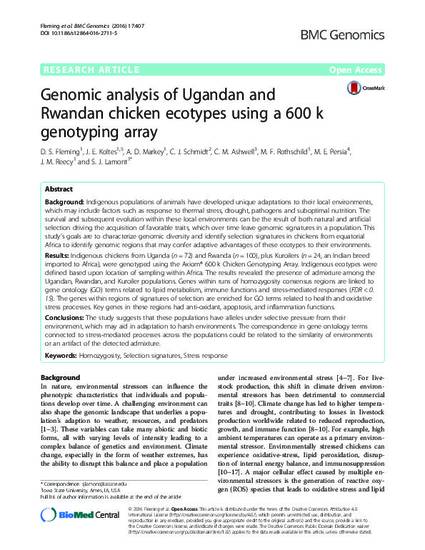
Background
Indigenous populations of animals have developed unique adaptations to their local environments, which may include factors such as response to thermal stress, drought, pathogens and suboptimal nutrition. The survival and subsequent evolution within these local environments can be the result of both natural and artificial selection driving the acquisition of favorable traits, which over time leave genomic signatures in a population. This study’s goals are to characterize genomic diversity and identify selection signatures in chickens from equatorial Africa to identify genomic regions that may confer adaptive advantages of these ecotypes to their environments. Results
Indigenous chickens from Uganda (n = 72) and Rwanda (n = 100), plus Kuroilers (n = 24, an Indian breed imported to Africa), were genotyped using the Axiom® 600 k Chicken Genotyping Array. Indigenous ecotypes were defined based upon location of sampling within Africa. The results revealed the presence of admixture among the Ugandan, Rwandan, and Kuroiler populations. Genes within runs of homozygosity consensus regions are linked to gene ontology (GO) terms related to lipid metabolism, immune functions and stress-mediated responses (FDR < 0.15). The genes within regions of signatures of selection are enriched for GO terms related to health and oxidative stress processes. Key genes in these regions had anti-oxidant, apoptosis, and inflammation functions. Conclusions
The study suggests that these populations have alleles under selective pressure from their environment, which may aid in adaptation to harsh environments. The correspondence in gene ontology terms connected to stress-mediated processes across the populations could be related to the similarity of environments or an artifact of the detected admixture.
Available at: http://works.bepress.com/max-rothschild/162/

This article is published as Fleming, D. S., J. E. Koltes, A. D. Markey, C. J. Schmidt, C. M. Ashwell, M. F. Rothschild, M. E. Persia, J. M. Reecy, and S. J. Lamont. "Genomic analysis of Ugandan and Rwandan chicken ecotypes using a 600 k genotyping array." BMC genomics 17 (2016): 407. doi: 10.1186/s12864-016-2711-5. Posted with permission.